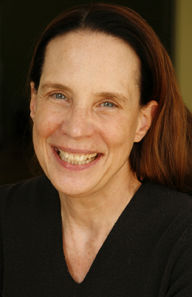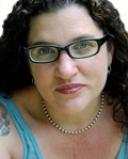Adolescence
Representing Young Mothers in Literature
An interview with the Amazing Katherine Arnoldi
Posted October 31, 2016

When The Amazing True Story of a Teenage Single Mom was first published in 1998, I’d never seen myself—a young mom—represented in a graphic novel. The brilliant book broke ground in feminist and working-class literature and offered a super hero all the single parents in my neighborhood could relate to. It’s that rare work that inspires on multiple level: The protagonist powers through domestic violence, unfair working conditions, and college, but it’s the lion-hearted creativity of the work itself that affirmed that I, too, could be an artist/writer/mother/power/media-maker in charge of my own excellent imagination. Eighteen years later, the book has been re-released from Graymalkin Media for a new generation. I caught up with the brilliant author-illustrator Katherine Arnoldi on the occasion of its rebirth—she talked to me from her home in the Bronx about her activism and art.

Ariel Gore: When I first happened upon The Amazing True Story of a Teenage Single Mom in the '90s, I was over the moon because it's such a beautiful and inspiring book, and also because I thought it heralded the beginning of a whole wave of books and stories by and about young, single moms--but the wave I imagined never really happened. Why do you think it's still so rare to find a young, single mom protagonist in literature?
Katherine Arnoldi: It is rare to see young mothers in literature, but there are writers who have inspired me. Tillie Olsen, who was a teenage mother and whose first publication at Partisan Review came the year she gave birth is the mother of us all. Her “I Stand Here Ironing” is, to me, the best short story ever written and I have committed it to memory just from so many readings. The last sentence is my favorite last sentence in all of literature. Toni Morrison’s The Bluest Eye (1970) has a teenager who gives birth but the child does not live. Maya Angelou’s I Know Why the Caged Bird Sings (1969) has a teenage mother. Beverly Donofrio’s Riding in Cars with Boys (1990) was a great inspiration to me. When I first read it, I finished it in one sitting, then opened it and read it again. I saw the sun come up and was never the same; the book inspired me to believe that my little zine cartoon book. The Amazing True Story of a Teenage Single Mom, which I copied myself and tried to distribute at GED programs and, later, at Charas Community Center on the Lower East Side where I was running a Single Mom College Program in the mid-1990s could actually become a book. The Hip Mama Survival Guide (1998) is a great inspiration, too. Along with Atlas of the Human Heart (2003), both by Ariel Gore.
The late and brilliant Allison Crews, who started Girl Mom, is also a great inspiration.
In 2000, I started, with New York Civil Liberties Union, a class action lawsuit against the New York City Board of Education for coercing teen mothers to leave high school. . . The interns at NYCLU pretended they were teen moms and called 28 high schools in New York City and only six would let them in.
Ariel Gore: You’re too kind to mention me in that company! It's been 18 years since the book's original publication. How has the world changed for mothers who live outside society's prescription for the perfect family?

Katherine Arnoldi: In 2000, I started, with New York Civil Liberties Union, a class action lawsuit against the New York City Board of Education for coercing teen mothers to leave high school. I was seeing so many teen moms in homeless shelters who told me that they were told to leave high school because the school “did not have insurance” or the “elevator wasn’t working.” The interns at NYCLU pretended they were teen moms and called 28 high schools in New York City and only six would let them in. Now, allegedly, things are better, but there are 11,000 new teen moms in New York City and only about 1,000 slots in the LYFE program, the childcare program in the high schools. What happens to the other 9,000 teen moms? I teach at Bronx Community College and many of my students are teenage mothers. One has never missed a class but has been in five homeless shelters during the two semesters she has taken my class. What has changed? Back in 1975 I was hitchhiking at the side of the road with my child. Then, cars and trucks passed us by, spraying us with water. Now, someone would veer off the road, pull out their phone and call 911, having me arrested and my child put in foster care.
What has changed? Back in 1975 I was hitchhiking at the side of the road with my child. Then, cars and trucks passed us by, spraying us with water. Now, someone would veer off the road, pull out their phone and call 911, having me arrested and my child put in foster care.
Ariel Gore: Do you see a fundamental conflict between being an artist and being a mother--whether the conflict comes from within or without? If so, what's the remedy?
Katherine Arnoldi: It is tough living in a neo-liberal, capitalist, market oriented, judgmental and heartless world.
I find solace in the inspiration from so many artist writer/mothers. Diane di Prima, who wrote the best mother poem ever, “Song for Baby-O, Unborn” in This Kind of Bird Flies Backward (1958). Hettie Jones’s How I Became Hettie Jones (1990) is a great inspiration. Cartoonists Joyce Farmer (Tits and Clits, 1970s. MaMa Dramas, 1978, Special Exits, 2010), Trina Robbins (MaMa Dramas, 1978) and Sabrina Jones (Girl Talk 1990s, Isadora Duncan, Margaret Sanger), and the zinester China Martens (Future Generation, 1990s to present) are also great inspirations.
I say the remedy is reading all the above and Ariel Gore, Adrienne Rich, bell hooks, Tillie Olsen, Beverly Donofrio, Audre Lourde and so many more until you realize that the world they suggest, based on a creative life, is one we want to live in.
I say the remedy is reading all the above and Ariel Gore, Adrienne Rich, bell hooks, Tillie Olsen, Beverly Donofrio, Audre Lourde and so many more until you realize that the world they suggest, based on a creative life, is one we want to live in.
Ariel Gore: How do you balance your writing and your visual art? Are there years you focus on one more than the other? Is the creative process very different for you?
Katherine Arnoldi: The graphic novel form allows me to combine both. The drawings in The Amazing True Story of a Teenage Single Mom (the title, by the way, is a take off of The Amazing True Story of Spiderman. When Marvel and DC introduce a new character they always title the first in the series like that) are not good but look like a teenager may have done them, which may have some form and function. I have been criticized for the quality of the drawings by those I admire and I admit the truth. However, when I made it I did not know that there was such a thing as a graphic novel, had never seen or read one.
Ariel Gore: Do you have any advice for moms who want to go to college without getting buried in debt?
Katherine Arnoldi: Stay away from online scam colleges that will take your Pell Grant and give you loans for an “education” that means nothing.
When I had my College Mom Magazine, Enid Mastrianni (of Upstate Welfare Warriors) and I analyzed the top 300 colleges for accessibility. There were some bright spots. UC Davis takes Section 8 in family housing. The University of Florida at Gainesville has $28 a month child care in their Baby Gator child care center and good cheap family housing (it was built after WWII for veterans). At City University of New York the majority graduate with no school loans. Stick with the state colleges unless a private school gives you a full scholarship with no loans. Get the full financial aid by claiming yourself independent and getting the full Pell and SEOG grant. Remember: graduate school through to the doctorate should be free. Most schools will give you a stipend for an assistantship and waive tuition.
Order The Amazing True Story of a Teenage Single Mom (Graymalkin Media, October, 2016) from your local, independent bookseller.




